Deep Hook Removal For Bass
Posted: Wed May 30, 2007 8:49 pm
This is the walk through that was featured on Basscenter on how to remove the hook out of the gullet of a bass. I have used this technique successfully many times and by knowing this you can properly handle a deeply hooked bass without damaging the fish.
(1) With the hook in the gullet, note which side of the fish's mouth the hook shank is toward. Note: For illustration sake, the line is eliminated here in steps 2 through 5. In reality, the line stays connected as this technique is performed.
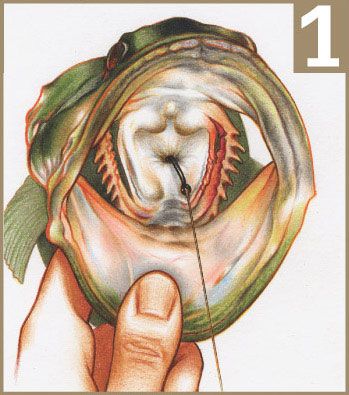
(2) With a finger or two, reach in through the last gill arch on that side of the fish and push and pull down on the hookeye so the hook turns and . . .
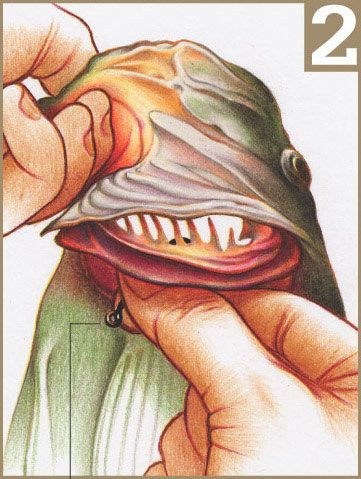
(3) rolls out below the gill toward the side of the fish. At that point, amazingly, the hook, barb and all, almost always pops free from its hold in the fish's gullet.
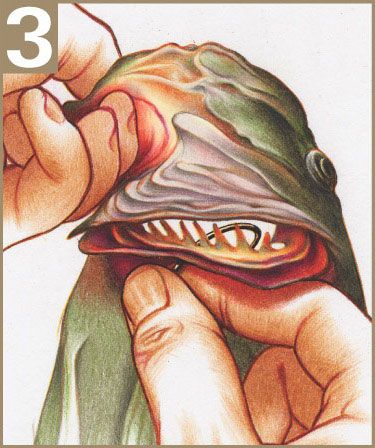
(4) Reach into the fish's mouth and grip the bend in the hook (which is now up) and . . .
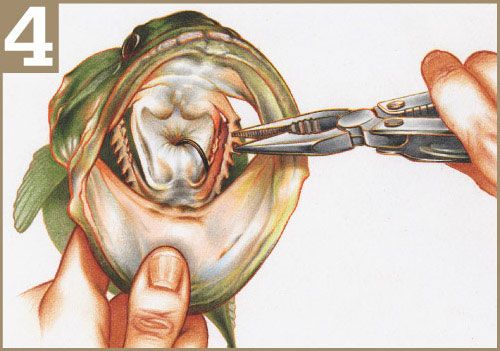
(5) lift it free. If the fish's mouth is too small to reach in with your hand, use a needle-nose pliers to grip the hook bend.
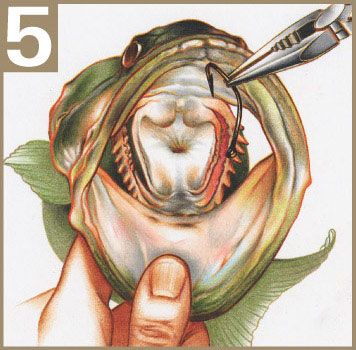
Emphasized- how resilient a fish's gills actually are, far from being the fragile organs often suggest by some sources. And the occasional bleeding fish? Does it have to be kept?: "Just get the fish back into the water as soon as possible and, more often than not, the bleeding stops--at least we've caught these fish again and again.
The technique also works superbly on walleyes, smallmouths, and other fish, usually taken on smaller hooks, often salmon-style hooks:
* Look down the throat to check the hook position. If it's set in the throat or gullet--or it's out of sight--give a gentle pull on the line and the hook eye usually emerges.
* Check which side the hook shank is on. Then open the gill flap and, with small walleyes, use a forceps to grip the hook shank just below the eye. Roll the hook out toward the gill and side of the body of the fish and the hook and barb pop free from the lining of the gullet.
Simple as that. Really, it's amazing. With a bit of practice, you'll be killing fewer fish--indeed, almost no fish that you plan to release.
Once these techniques become much more widely used, we'll have taken another large step forward in helping to sustain better fishing based on a commitment to release some fish so they can be caught again.
fishnislife
(1) With the hook in the gullet, note which side of the fish's mouth the hook shank is toward. Note: For illustration sake, the line is eliminated here in steps 2 through 5. In reality, the line stays connected as this technique is performed.

(2) With a finger or two, reach in through the last gill arch on that side of the fish and push and pull down on the hookeye so the hook turns and . . .

(3) rolls out below the gill toward the side of the fish. At that point, amazingly, the hook, barb and all, almost always pops free from its hold in the fish's gullet.

(4) Reach into the fish's mouth and grip the bend in the hook (which is now up) and . . .

(5) lift it free. If the fish's mouth is too small to reach in with your hand, use a needle-nose pliers to grip the hook bend.

Emphasized- how resilient a fish's gills actually are, far from being the fragile organs often suggest by some sources. And the occasional bleeding fish? Does it have to be kept?: "Just get the fish back into the water as soon as possible and, more often than not, the bleeding stops--at least we've caught these fish again and again.
The technique also works superbly on walleyes, smallmouths, and other fish, usually taken on smaller hooks, often salmon-style hooks:
* Look down the throat to check the hook position. If it's set in the throat or gullet--or it's out of sight--give a gentle pull on the line and the hook eye usually emerges.
* Check which side the hook shank is on. Then open the gill flap and, with small walleyes, use a forceps to grip the hook shank just below the eye. Roll the hook out toward the gill and side of the body of the fish and the hook and barb pop free from the lining of the gullet.
Simple as that. Really, it's amazing. With a bit of practice, you'll be killing fewer fish--indeed, almost no fish that you plan to release.
Once these techniques become much more widely used, we'll have taken another large step forward in helping to sustain better fishing based on a commitment to release some fish so they can be caught again.
fishnislife